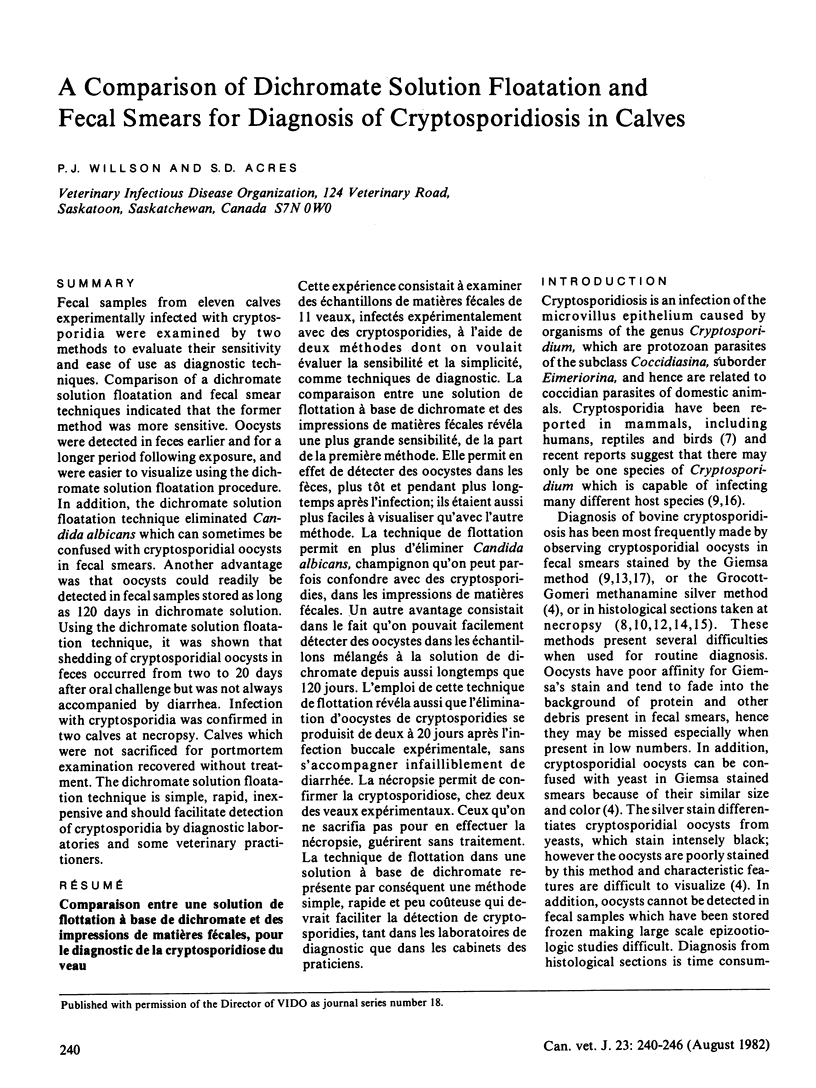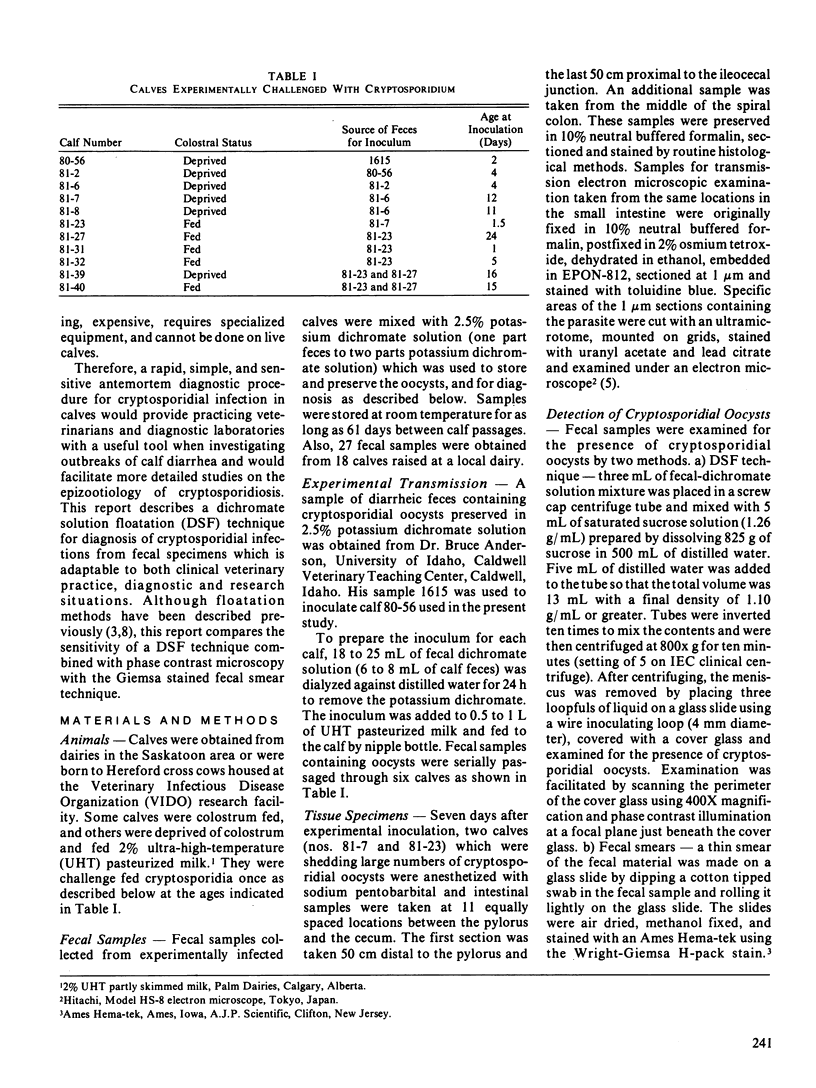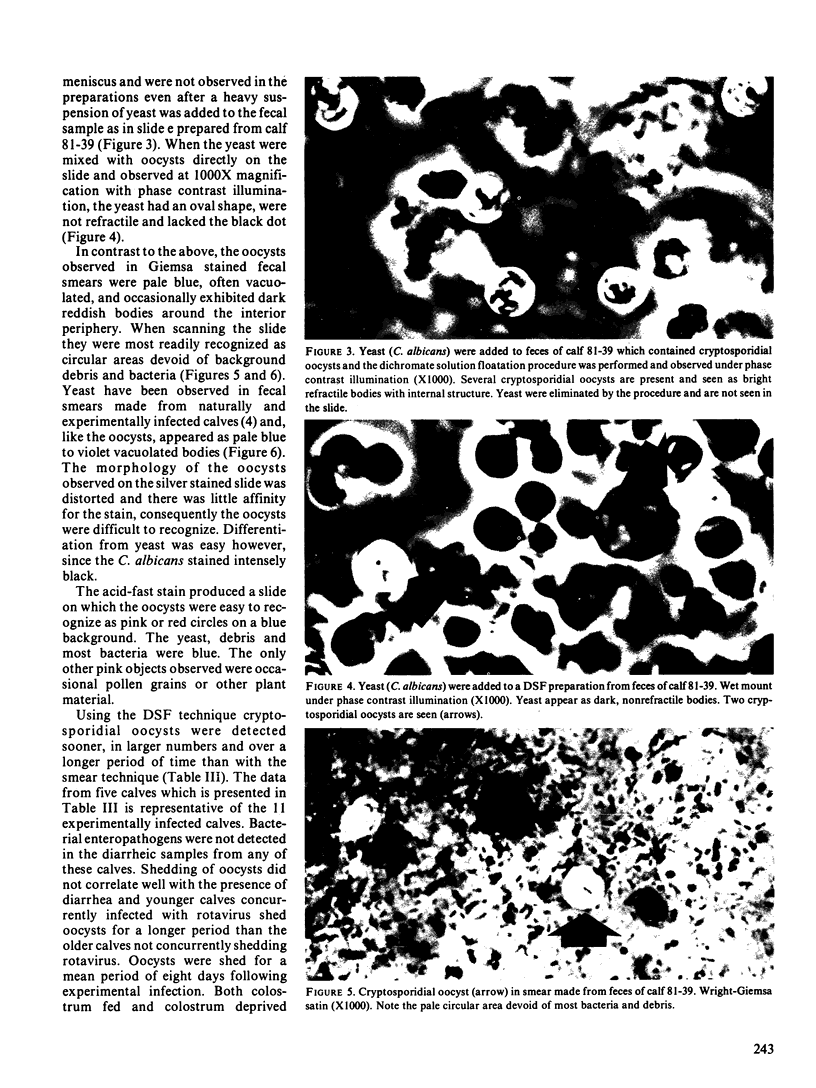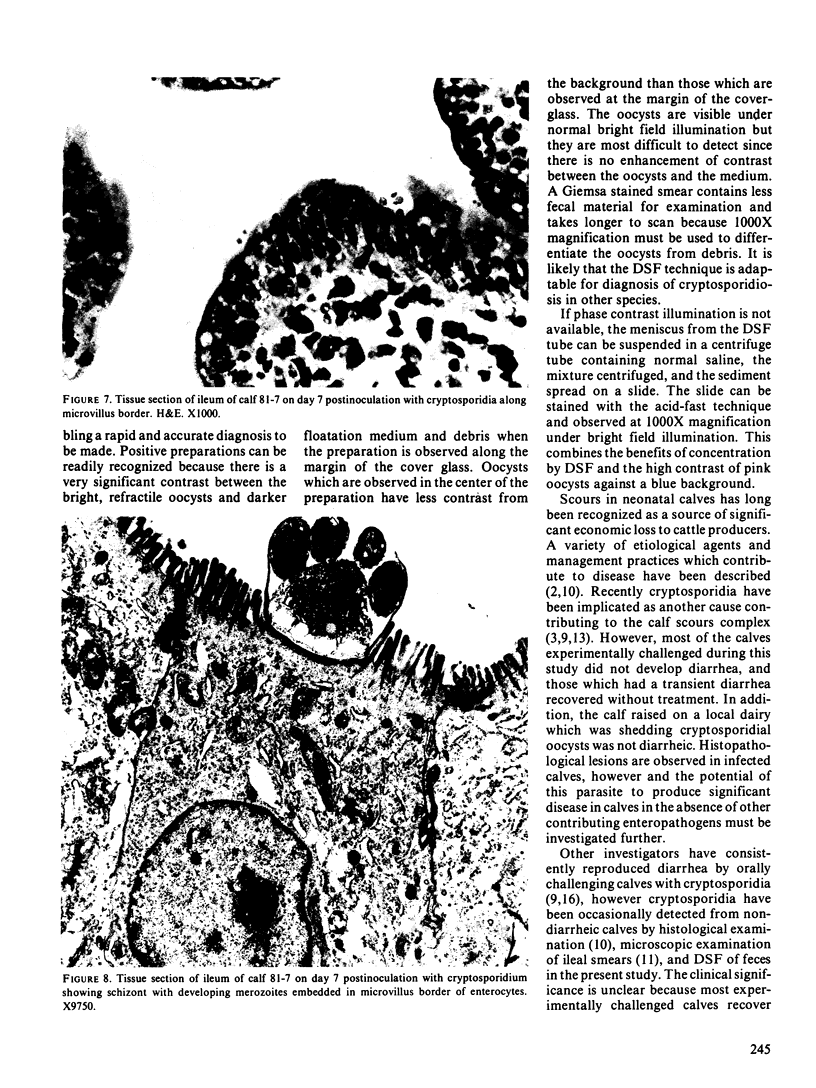Abstract
Fecal samples from eleven calves experimentally infected with cryptosporidia were examined by two methods to evaluate their sensitivity and ease of use as diagnostic techniques. Comparison of a dichromate solution floatation and fecal smear techniques indicated that the former method was more sensitive. Oocysts were detected in feces earlier and for a longer period following exposure, and were easier to visualize using the dichromate solution floatation procedure. In addition, the dichromate solution floatation technique eliminated Candida albicans which can sometimes be confused with cryptosporidial oocysts in fecal smears. Another advantage was that oocysts could readily be detected in fecal samples stored as long as 120 days in dichromate solution. Using the dichromate solution floatation technique, it was shown that shedding of cryptosporidial oocysts in feces occurred from two to 20 days after oral challenge but was not always accompanied by diarrhea. Infection with cryptosporidia was confirmed in two calves at necropsy. Calves which were not sacrificed for portmortem examination recovered without treatment. The dichromate solution floatation technique is simple, rapid, inexpensive and should facilitate detection of cryptosporidia by diagnostic laboratories and some veterinary practitioners.
Full text
PDF






Images in this article
Selected References
These references are in PubMed. This may not be the complete list of references from this article.
- Acres S. D., Forman A. J., Kapitany R. A. Antigen-extinction profile in pregnant cows, using a K99-containing whole-cell bacterin to induce passive protection against enterotoxigenic colibacillosis of calves. Am J Vet Res. 1982 Apr;43(4):569–575. [PubMed] [Google Scholar]
- Acres S. D., Saunders J. R., Radostits O. M. Acute undifferentiated neonatal diarrhea of beef calves: the prevalence of enterotoxigenic E. coli, reo-like (rota) virus and other enteropathogens in cow-calf herds. Can Vet J. 1977 May;18(5):113–121. [PMC free article] [PubMed] [Google Scholar]
- Anderson B. C. Patterns of shedding of cryptosporidial oocysts in Idaho calves. J Am Vet Med Assoc. 1981 May 1;178(9):982–984. [PubMed] [Google Scholar]
- Angus K. W., Campbell I., Gray E. W., Sherwood D. Staining of faecal yeasts and cryptosporidium oocysts. Vet Rec. 1981 Feb 21;108(8):173–173. doi: 10.1136/vr.108.8.173. [DOI] [PubMed] [Google Scholar]
- Bellamy J. E., Acres S. D. Enterotoxigenic colibacillosis in colostrum-fed calves: pathologic changes. Am J Vet Res. 1979 Oct;40(10):1391–1397. [PubMed] [Google Scholar]
- Dean A. G., Ching Y. C., Williams R. G., Harden L. B. Test for Escherichia coli enterotoxin using infant mice: application in a study of diarrhea in children in Honolulu. J Infect Dis. 1972 Apr;125(4):407–411. doi: 10.1093/infdis/125.4.407. [DOI] [PubMed] [Google Scholar]
- Kennedy G. A., Kreitner G. L., Strafuss A. C. Cryptosporidiosis in three pigs. J Am Vet Med Assoc. 1977 Feb 1;170(3):348–350. [PubMed] [Google Scholar]
- Meuten D. J., Van Kruiningen H. J., Lein D. H. Cryptosporidiosis in a calf. J Am Vet Med Assoc. 1974 Nov 15;165(10):914–917. [PubMed] [Google Scholar]
- Moon H. W., Bemrick W. J. Fecal transmission of calf cryptosporidia between calves and pigs. Vet Pathol. 1981 Mar;18(2):248–255. doi: 10.1177/030098588101800213. [DOI] [PubMed] [Google Scholar]
- Pearson G. R., Logan E. F. Demonstration of Cryptosporidia in the small intestine of a calf by light, transmission electron and scanning electron microscopy. Vet Rec. 1978 Sep 2;103(10):212–213. doi: 10.1136/vr.103.10.212. [DOI] [PubMed] [Google Scholar]
- Pohlenz J., Moon H. W., Cheville N. F., Bemrick W. J. Cryptosporidiosis as a probable factor in neonatal diarrhea of calves. J Am Vet Med Assoc. 1978 Feb 15;172(4):452–457. [PubMed] [Google Scholar]
- Powell H. S., Holscher M. A., Heath J. E., Beasley F. F. Bovine cryptosporidiosis (a case report). Vet Med Small Anim Clin. 1976 Feb;71(2):205–207. [PubMed] [Google Scholar]
- Snodgrass D. R., Angus K. W., Gray E. W., Keir W. A., Clerihew L. W. Cryptosporidia associated with rotavirus and an Escherichia coli in an outbreak of calf scour. Vet Rec. 1980 May 31;106(22):458–460. doi: 10.1136/vr.106.22.458-a. [DOI] [PubMed] [Google Scholar]
- Tzipori S., Angus K. W., Campbell I., Gray E. W. Cryptosporidium: evidence for a single-species genus. Infect Immun. 1980 Dec;30(3):884–886. doi: 10.1128/iai.30.3.884-886.1980. [DOI] [PMC free article] [PubMed] [Google Scholar]
- Tzipori S., Campbell I., Sherwood D., Snodgrass D. R., Whitelaw A. An outbreak of calf diarrhoea attributed to cryptosporidial infection. Vet Rec. 1980 Dec 20;107(25-26):579–580. [PubMed] [Google Scholar]










